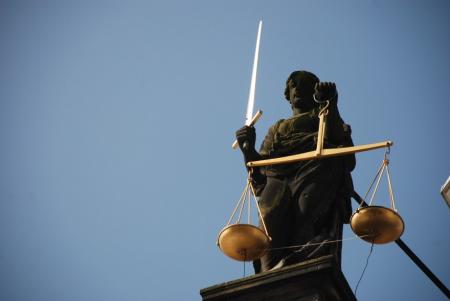 A plaque on the wall of courtroom 46 in the Bombay high court proclaims: “There are higher powers that rule the destiny of men and nations and it may be the will of Providence that the cause which I represent may prosper more by my suffering than by my remaining free.”
A plaque on the wall of courtroom 46 in the Bombay high court proclaims: “There are higher powers that rule the destiny of men and nations and it may be the will of Providence that the cause which I represent may prosper more by my suffering than by my remaining free.”
The plaque remembers Bal Gangadhar Tilak’s defiant speech to the court in 1909 after being sentenced to a Burmese prison for six years. He had been convicted of sedition. Tilak’s cause was not restricted to political freedom; as the editor of the Kesari, at the time the highest circulating newspaper in India, Tilak represented freedom of speech in the country. One hundred and seven years later, what would Tilak have made of the republic he helped create?
Sedition lingers on in India, refusing to go away, silencing students, doctors and writers today as it did nationalist leaders a century ago. Even as other advanced democracies have abolished the offence of sedition, it has enjoyed a resurgence in India. This is ironic because sedition had an uncertain birth.
“An unaccountable mistake”
Although present in Thomas Macaulay’s draft penal law submitted to Governor-General George Eden in 1837, the offence mysteriously vanished when the Indian Penal Code was enacted in 1860. It was an “unaccountable mistake,” said James Stephen, the Viceroy’s law minister, which he remedied by re-introducing the sedition offence ten years later in 1870.
A mistake seems unlikely, although it is the most cited explanation. The Indian Penal Code was an important pillar of colonial rule in India, enacted only two years after the Great Revolt of 1857 ended. If the colonial authorities simply forgot to enact Macaulay’s draft sedition offence, which would have enabled the silencing of other would-be critics of British rule, it was a lapse of incomparable negligence.
On the other hand, some commentators have argued sedition was deliberately left out of the law. This view claims the sedition offence was unnecessary since the colonial government had already heavily policed speech. Its reappearance in 1870 is attributed to administrative alarm at the mostly imagined ‘Wahabee’ conspiracy, which culminated in several failed trials because the colonial government’s evidence was too feeble even for a colonial court. A more catch-all provision was needed.
The golden age
Enter the sedition offence. Enacted in 1870, it criminalised speech that “excited feelings of disaffection to the Government.” This peculiar Victorian formulation remains the law in India today. In 1898, one year after Tilak’s first sedition trial, the offence was widened to embrace the bringing of the government into “hatred or contempt.” The language is significant; it protects the government, not the nation.
Doubly fortified by their expansive sedition law, the colonial authorities swiftly swung into action. Several regional newspapers across the country were targeted, their editors arrested. Sedition was not restricted to the press; it was used against theatre artistes, writers and folk singers.
These measures were accompanied by a significant infrastructural build-up of censorship law. Magistrates were given the power to preemptively bind potentially seditious people to a bond; this had the effect of making sedition a prospective crime without the state having to meet a minimal burden of proof. The hitherto unknown offence of promoting inter-class enmity was created. Vague laws were made to ban seditious meetings and nationalist newspapers.
This was sedition’s heyday. It shackled the speech and freedoms of Indians. In 1922, Mohandas Gandhi was tried for sedition. He was defiant in the face of his conviction: “I am here to submit to the highest penalty that can be inflicted upon me for what appears to me (sedition) to be the highest duty of a citizen. The only course open to you, the Judge, is either to resign your post or to inflict on me the severest penalty.”
A bad bequest
When the British left India, they left their laws behind. Free India inherited the sedition offence along with the rest of the colonial state’s censorship apparatus. Why were these provisions not immediately repealed? Perhaps the nascent Indian state was insecure. Born amidst strife and volatility, it turned to the same laws that enabled colonial control.
Sedition was rejected by the Constituent Assembly, so it was overridden by the constitutional right to free speech. But it remained in the Indian Penal Code. In 1951, Prime Minister Jawaharlal Nehru substantially weakened the right to free speech by making it subject to ‘public order,’ a nebulous concept that shelters the sedition offence.
Nehru said sedition was an “objectionable and obnoxious” offence, but his government did nothing to repeal it. For his part in preserving the legal architecture of colonial rule, Nehru must be harshly judged. Later, on the eve of the Bangladesh War in 1971, the Law Commission of India thumpingly endorsed the criminalisation of sedition because its “ultimate end is to destroy the bond between the Government and those whose obedience the Government is entitled to command.”
What would Gandhi have made of this claim that sees citizens as obedient subjects? “Affection (to the Government) cannot be manufactured or regulated by law,” he told the judge at his trial. “[Sedition] is the prince among the political sections of the [law] designed to suppress the liberty of the citizen.”
An unwelcome return
Tilak, Gandhi and their compatriots are long gone, as has colonialism that Gandhi described as “a subtle system of terrorism.” In 1950, the Punjab high court (as it was then called and based in Shimla) struck down the offence because “[a] law of sedition thought necessary during a period of foreign rule has become inappropriate by the very nature of the change which has come about.”
In 1958, the Allahabad high court struck down the offence of sedition for “striking at the very root of the Constitution which is free speech.” Unfortunately, this and other decisions were overturned by the Supreme Court in 1962, amidst the war with China. Thus, the colonial offence of sedition remains alive.
Many decades have passed since the creation of the republic, and the anxiety that afflicted the newly-created India has abated. But today’s government appears no less insecure than its predecessors. For many people, the claims that were made at Jawaharlal Nehru University on February 9, 2016, are simple truths. For others who take a different view, the claims represent dissenting opinions. The law must protect dissent, it is the cornerstone of freedom in a democracy.
In recent years, sedition has been applied against anti-nuclear protestors, a doctor, cartoonists, writers, editors, professors and students. All of them were peaceful and non-violent; their views did not incite imminent violence. Their circumstances are quite similar to the previous century’s victims of colonial rule, during the golden age of sedition.
The increasing use of sedition in the twenty-first century, no matter the government in power, has set India upon a dangerous, backwards-facing trajectory. This must be corrected. Sedition is an outdated offence, incompatible with modern India. It must be weeded out of the law.
Bhairav Acharya is a lawyer who is interested in free speech. He is presently at Berkeley.
